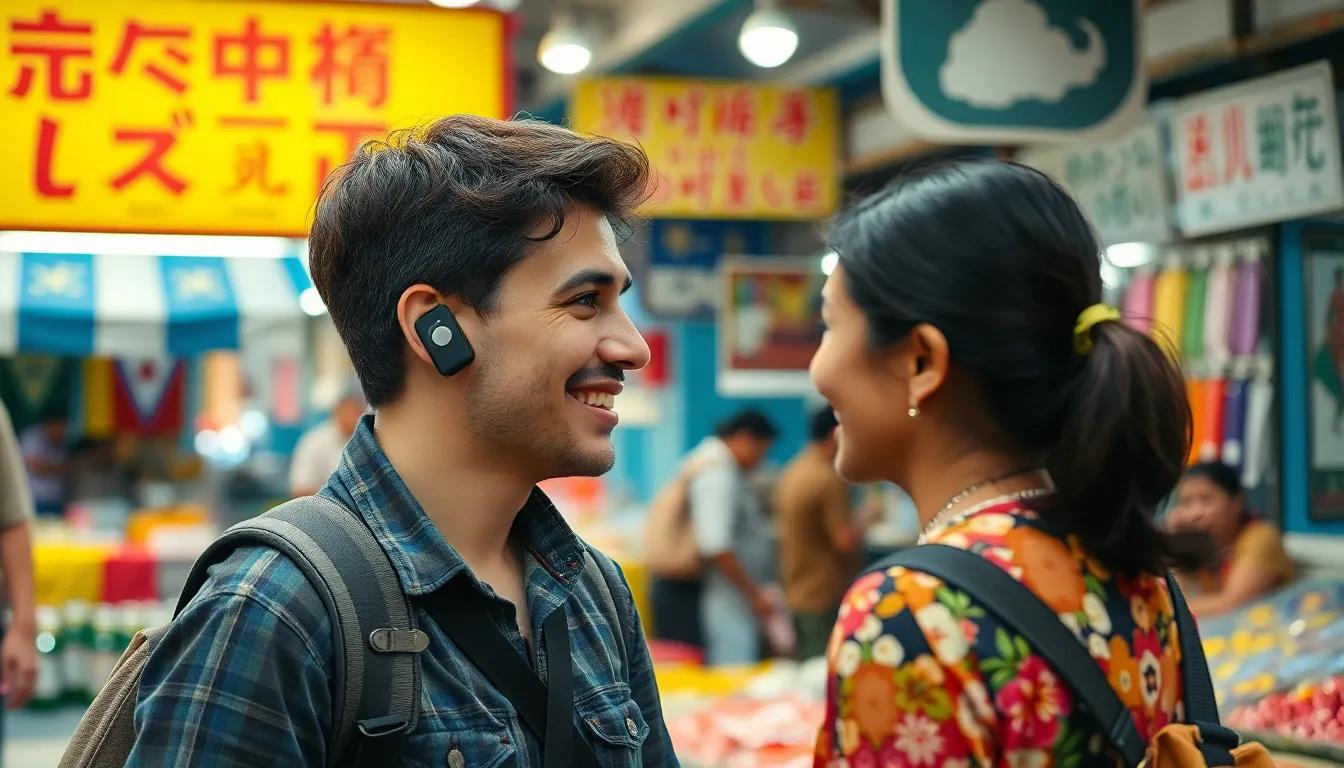Table of Contents
ToggleImagine strolling through a bustling market in Tokyo, trying to haggle over the price of a mysterious fruit, but the language barrier feels like a brick wall. Enter wearable AI translators, the stylish sidekick every globetrotter never knew they needed. These nifty gadgets are not just tech-savvy; they’re the ultimate travel companions that turn awkward moments into smooth conversations faster than you can say “lost in translation.”
Overview of Wearable AI Translators
Wearable AI translators emerge as indispensable tools for travelers seeking to navigate linguistic challenges effortlessly. These compact devices integrate advanced language processing technologies, enabling real-time translations across multiple languages. Users engage in seamless conversations without the need for traditional translation methods.
Recent advancements allow wearable translators to pack immense capabilities into lightweight formats. Many models feature voice recognition, which captures spoken language and translates it instantly. Such functionality proves handy during business meetings or casual interactions, ensuring clarity and understanding.
Statistics reveal that more than 50% of travelers experience language barriers during their journeys. Due to this, the demand for wearables in this sector has surged significantly. As a result, leading brands continue to innovate, producing devices with enhanced accuracy and expanded language databases.
Bluetooth connectivity allows these devices to pair with smartphones, enriching their translation capabilities. Artificial intelligence algorithms improve their performance over time, learning from user interactions. Contextual translation plays a crucial role, ensuring the words translated reflect the intended meaning rather than literal interpretations.
Some wearables also provide additional features, such as language learning tools or cultural tips, offering more than just translation. Flexibility in design accommodates various settings, whether a bustling marketplace or a quiet cafe.
Investing in wearable AI translators saves time and alleviates stress associated with language barriers. With simple setup processes, users can hit the ground running during their travels, enhancing their overall experiences abroad.
Key Features of Wearable AI Translators

Wearable AI translators come equipped with several features that enhance their usability for travelers. They provide instant communication solutions that reduce language-related stress.
Real-Time Translation
Real-time translation stands out as a primary feature. Users experience immediate audio translations, allowing spontaneous dialogue without interruptions. Device algorithms recognize spoken words, converting them into the target language almost instantly. This responsiveness facilitates smooth exchanges, whether during casual conversations or formal business meetings. Enhanced voice recognition technology ensures accuracy, even in noisy environments. Many devices operate seamlessly in various settings, making them versatile tools across different cultures. Travelers find this capability invaluable, as it allows for natural interactions and strengthens connections with locals.
Language Support
Language support is crucial for comprehensive functionality. Many wearable AI translators cover over 30 languages, including widely spoken ones like Mandarin and Spanish. Such extensive databases allow for effective communication across diverse regions. Some devices offer dialect options, catering to variations in regional speech. Regular updates improve language packs, ensuring users access the latest translations. Additionally, many devices include less common languages, broadening accessibility for travelers exploring remote areas. Effective language support enhances overall user experience, making these devices indispensable travel companions.
Popular Wearable AI Translator Devices
Wearable AI translators have gained popularity among travelers seeking smooth communication. These devices offer various features that enhance their performance, making them essential travel companions.
Device 1: Features and Performance
This device boasts real-time translation capabilities across more than 30 languages, ensuring fluent conversations. Users appreciate its advanced voice recognition technology, which adapts well to busy environments. High accuracy levels help convey meanings effectively, reducing misunderstandings. Its sleek design and lightweight build promote portability, making it easy to carry during trips. With regular software updates, language packs continually improve, keeping translations relevant and reliable. Integrating Bluetooth connectivity allows users to synchronize it with smartphones, expanding its functions efficiently.
Device 2: Features and Performance
Another notable device excels with seamless real-time translation across 40 languages, including various dialects. Enhanced noise cancellation features effectively filter background sounds, making conversations clearer. Travelers can rely on its AI-driven algorithms that learn from user interactions, resulting in improved translation accuracy over time. The ergonomic design ensures comfort during prolonged use, while built-in cultural tips enrich the travel experience. Users enjoy additional functionalities such as language learning tools, providing an extra layer of assistance for engaging with locals.
Use Cases of Wearable AI Translators
Wearable AI translators serve vital roles in various settings, enhancing communication across languages in real-world scenarios.
Travel and Tourism
Travelers benefit immensely from wearable AI translators. These devices facilitate essential interactions, such as ordering food or asking for directions, eliminating the stress of language barriers. They allow for spontaneous conversations with locals, enriching the travel experience. In busy cities, these translators prove invaluable, enabling visitors to navigate diverse environments with ease. Current statistics reveal that over 50% of travelers encounter language difficulties, driving demand for effective tools that promote seamless interactions. Advanced models provide real-time translations in more than 30 languages, ensuring that tourists can engage meaningfully with local cultures and customs.
Business Communication
In business settings, wearable AI translators enhance communication during meetings and negotiations. Instant translations allow professionals to communicate without delays, fostering collaboration across language barriers. Companies gain a competitive edge through streamlined interactions when traveling internationally. Many devices feature noise cancellation technology, ensuring clarity even in bustling environments. Regular updates improve accuracy, helping professionals stay connected and informed. Statistics indicate that effective communication contributes significantly to successful business outcomes. By integrating these translators into their workflows, businesses can navigate global markets more efficiently, making them essential tools for modern professionals.
Challenges and Limitations
Wearable AI translators face several challenges that impact their effectiveness. Accuracy remains a primary concern, especially when it comes to idiomatic expressions and cultural nuances. Many devices struggle to interpret context appropriately, leading to misunderstandings in conversations.
Connectivity issues also arise when relying on Bluetooth for real-time translations. Signal disruptions can hinder communication, particularly in crowded areas or when users are in motion. Battery life can become a limiting factor, as prolonged use without charging can leave travelers without necessary translation assistance.
Additionally, language support varies significantly between devices. Some wearable AI translators might not cover specific dialects or regional variations, restricting their usability in certain areas. Often, users find that recent languages and updates aren’t immediately available, affecting their ability to communicate effectively.
User interface design can create a learning curve. Some travelers might find it challenging to navigate features, especially if they aren’t tech-savvy. Clunky interfaces can detract from the user experience, making it harder for individuals to obtain quick translations.
Privacy concerns also exist regarding data handling. Many devices collect user data for performance enhancement, raising questions about consent and security. Users must remain aware of the potential for personal information exposure when utilizing these technologies.
Costs associated with high-quality wearable AI translators can deter some potential users. While the advantages may outweigh expenses for frequent travelers, casual users may hesitate to invest in advanced models. Balancing features, performance, and price points is essential for appealing to a broader audience.
Wearable AI translators are revolutionizing how people communicate across languages. These innovative devices not only empower travelers to navigate foreign environments with confidence but also enhance business interactions by breaking down language barriers. As technology continues to evolve, the accuracy and functionality of these translators will only improve.
The growing demand for seamless communication tools underscores the importance of bridging cultural gaps. With their compact design and advanced features, wearable AI translators are set to become essential companions for anyone looking to explore the world or engage in global commerce. Embracing this technology can lead to richer experiences and deeper connections, making travel and collaboration more enjoyable and effective.




